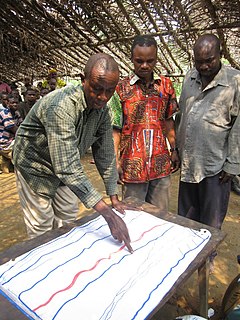Related Research Articles

Planning theory is the body of scientific concepts, definitions, behavioral relationships, and assumptions that define the body of knowledge of urban planning. There are nine procedural theories of planning that remain the principal theories of planning procedure today: the Rational-Comprehensive approach, the Incremental approach, the Transformative Incremental (TI) approach, the Transactive approach, the Communicative approach, the Advocacy approach, the Equity approach, the Radical approach, and the Humanist or Phenomenological approach.

Urban design is the process of designing and shaping the physical features of cities, towns, and villages and planning for the provision of municipal services to residents and visitors. Although it deals with issues of a larger scale than architecture, it cannot be understood as a wholly separated field of research and design, since the quality of one depends on the quality of the other. In fact, it is this very interdependency, which has been termed relational design by Barcelona-based architect Enric Massip-Bosch, which makes urban design and architecture inextricably linked in many university education programs, especially in Europe. This tendency towards reintegration in architectural studies is also gaining momentum in the USA.
Land-use planning is the process of regulating the use of land by a central authority. Usually, this is done in an effort to promote more desirable social and environmental outcomes as well as a more efficient use of resources. More specifically, the goals of modern land-use planning often include environmental conservation, restraint of urban sprawl, minimization of transport costs, prevention of land use conflicts, and a reduction in exposure to pollutants. In the pursuit of these goals, planners assume that regulating the use of land will change the patterns of human behavior, and that these changes are beneficial. The first assumption, that regulating land-use changes the patterns of human behavior is widely accepted. However, the second assumption - that these changes are beneficial - is contested, and depends on the location and regulations being discussed.

Communicative rationality or communicative reason is a theory or set of theories which describes human rationality as a necessary outcome of successful communication. In particular, it is tied to the philosophy of German philosophers Karl-Otto Apel and Jürgen Habermas, and their program of universal pragmatics, along with its related theories such as those on discourse ethics and rational reconstruction. This view of reason is concerned with clarifying the norms and procedures by which agreement can be reached, and is therefore a view of reason as a form of public justification.
Neighborhood planning is a form of urban planning through which professional urban planners and communities seek to shape new and existing neighborhoods. It can denote the process of creating a physical neighborhood plan, for example via participatory planning, or an ongoing process through which neighborhood affairs are decided.

Environmental planning is the process of facilitating decision making to carry out land development with the consideration given to the natural environment, social, political, economic and governance factors and provides a holistic framework to achieve sustainable outcomes. A major goal of environmental planning is to create sustainable communities, which aim to conserve and protect undeveloped land.

Placemaking is a multi-faceted approach to the planning, design and management of public spaces. Placemaking capitalizes on a local community's assets, inspiration, and potential, with the intention of creating public spaces that promote people's health, happiness, and well-being. It is political due to the nature of place identity. Placemaking is both a process and a philosophy that makes use of urban design principles. It can be either official and government led, or community driven grass roots tactical urbanism, such as extending sidewalks with chalk, paint, and planters, or open streets events such as Bogotá, Colombia's Ciclovía. Good placemaking makes use of underutilized space to enhance the urban experience at the pedestrian scale to build habits of locals.
Public participation, also known as citizen participation or patient and public involvement, is the inclusion of the public in the activities of any organization or project. Public participation is similar to but more inclusive than stakeholder engagement.
Jean Hillier is Professor Emerita in the Centre for Urban Research at RMIT University, Melbourne, Australia
Patsy Healey is a British urban planner. She is professor emeritus at Global Urban Research Unit in the School of Architecture, Planning & Landscape, at Newcastle University. She is a specialist in planning theory and practice, with a particular focus on strategic spatial planning for city regions and in urban regeneration policies. She is Senior Editor of Planning Theory and Practice journal, jointly published by TandF and the RTPI.
Radical democracy is a type of democracy that advocates the radical extension of equality and liberty. Radical democracy is concerned with a radical extension of equality and freedom, following the idea that democracy is an un-finished, inclusive, continuous and reflexive process.

Participatory planning is an urban planning paradigm that emphasizes involving the entire community in the community planning process. Participatory planning emerged in response to the centralized and rationalistic approaches that defined early urban planning work. It has become a highly influential paradigm both in the context of traditional urban planning, and in the context of international community development. There is no singular theoretical framework or set of practical methods that make up participatory planning. Rather, it is a broad paradigm which incorporates a wide range of diverse theories and approaches to community planning. In general, participatory planning programs prioritize the integration of technical expertise with the preferences and knowledge of community members in the planning process. They also generally emphasize consensus building and collective community decision making, and prioritize the participation of traditionally marginalized groups in the planning process.
Governance is a broader concept than government and also includes the roles played by the community sector and the private sector in managing and planning countries, regions and cities. Collaborative governance involves the government, community and private sectors communicating with each other and working together to achieve more than any one sector could achieve on its own. Ansell and Gash (2008) have explored the conditions required for effective collaborative governance. They say “The ultimate goal is to develop a contingency approach of collaboration that can highlight conditions under which collaborative governance will be more or less effective as an approach to policy making and public management” Collaborative governance covers both the informal and formal relationships in problem solving and decision-making. Conventional government policy processes can be embedded in wider policy processes by facilitating collaboration between the public, private and community sectors. Collaborative Governance requires three things, namely: support; leadership; and a forum. The support identifies the policy problem to be fixed. The leadership gathers the sectors into a forum. Then, the members of the forum collaborate to develop policies, solutions and answers.
Inclusive management is a pattern of practices by public managers that facilitate the inclusion of public employees, experts, the public, and politicians in collaboratively addressing public problems or concerns of public interest.
Geodesign is a set of concepts and methods used to involve all stakeholders and various professions in collaboratively designing and realizing the optimal solution for spatial challenges in the built and natural environments, utilizing all available techniques and data in an integrated process. Originally, geodesign was mainly applied during the design and planning phase. "Geodesign is a design and planning method which tightly couples the creation of design proposals with impact simulations informed by geographic contexts." Now, it is also used during realization and maintenance phases and to facilitate re-use of for example buildings or industrial areas. Geodesign includes project conceptualization, analysis, design specification, stakeholder participation and collaboration, design creation, simulation, and evaluation.

Urban planning, also known as regional planning, town planning, city planning, or rural planning, is a technical and political process that is focused on the development and design of land use and the built environment, including air, water, and the infrastructure passing into and out of urban areas, such as transportation, communications, and distribution networks and their accessibility. Traditionally, urban planning followed a top-down approach in master planning the physical layout of human settlements. The primary concern was the public welfare, which included considerations of efficiency, sanitation, protection and use of the environment, as well as effects of the master plans on the social and economic activities. Over time, urban planning has adopted a focus on the social and environmental bottom-lines that focus on planning as a tool to improve the health and well-being of people while maintaining sustainability standards. Sustainable development was added as one of the main goals of all planning endeavors in the late 20th century when the detrimental economic and the environmental impacts of the previous models of planning had become apparent.. Similarly, in the early 21st century, Jane Jacob's writings on legal and political perspectives to emphasize the interests of residents, businesses and communities effectively influenced urban planners to take into broader consideration of resident experiences and needs while planning.
Advocacy planning is a theory of urban planning that was formulated in the 1960s by Paul Davidoff and Linda Stone Davidoff. It is a pluralistic and inclusive planning theory where planners seek to represent the interests of various groups within society. Davidoff (1965) was an activist lawyer and planner who believed that advocacy planning was a necessary method for representing the low-income and minority groups who were not always on equal footing with the rich and powerful.
Planning cultures are the differing customs and practices in the profession of urban and regional planning that exist around the world. The discourse, models, and styles of communication in planning are adapted to the various local conditions of each community such that planning approaches from one part of the world are not necessarily transferable to other parts of the globe. Planning culture can refer to how planning professionals undertake their practice in a given location, where they are "affected by both individual and collectively shared cognitive frames" that shape their view of the world. Planners, as stated by Simone Abram, are "constantly in the process of actually producing culture". The concept of planning culture also encompasses how planning actually unfolds within a community, as shaped by its culture and influenced by its people. Differing cultural contexts produce different planning and policy responses to issues "bound to specific local (cultural) contexts". Examples of planning cultures include those specific to different countries, regions, and parts of the globe, as well as differing cultures that exist within the same location, such as indigenous planning cultures.
Indigenous planning is an ideological approach to the field of regional planning where planning is done by Indigenous peoples for Indigenous communities. Practitioners integrate traditional knowledge or cultural knowledge into the process of planning. Indigenous planning recognizes that "all human communities plan" and that Indigenous communities have been carrying out their own community planning processes for thousands of years. While the broader context of urban planning, and social planning includes the need to work cooperatively with indigenous persons and organizations, the process in doing so is dependent on social, political and cultural forces.
Judith E. Innes was an American academic. She ended her career as professor emerita at the College of Environmental Design at the University of California, Berkeley. Her academic work focused on the areas of public policy, planning theory and process, collaborative planning, communicative planning, and multiple areas of urban planning including transportation and water planning. She held a Ph.D. in Urban Studies and Planning from MIT and a B.A. in English Literature from Harvard University. Innes died on April 14, 2020, aged 78.
References
- 1 2 3 4 5 6 7 8 Healey, Patsy (1997). Collaborative Planning: Shaping Places in Fragmented Societies. UBC Press. p. 5. ISBN 978-0774805988.
- 1 2 3 4 5 Healey, Patsy (1996). "The Communicative Turn in Planning Theory and its Implications for Spatial Strategy Formation". Environment and Planning B: Planning and Design. 23 (2): 217–234. doi:10.1068/b230217. S2CID 143878606.
- 1 2 Innes, Judith E.; Booher, David E. (1999-12-31). "Consensus Building and Complex Adaptive Systems". Journal of the American Planning Association. 65 (4): 412–423. doi:10.1080/01944369908976071. ISSN 0194-4363.
- 1 2 Booher, David E.; Innes, Judith E. (2002-03-01). "Network Power in Collaborative Planning". Journal of Planning Education and Research. 21 (3): 221–236. doi:10.1177/0739456X0202100301. ISSN 0739-456X. S2CID 110081649.
- 1 2 Innes, Judith E.; Booher, David E. (1999-03-31). "Consensus Building as Role Playing and Bricolage". Journal of the American Planning Association. 65 (1): 9–26. doi:10.1080/01944369908976031. ISSN 0194-4363.
- 1 2 Innes, Judith (1995). "Planning Theory's Emerging Paradigm: Communicative Action and Interactive Practice". Journal of Planning Education and Research. 14 (3): 183–189. doi:10.1177/0739456x9501400307. S2CID 146505480.
- ↑ Erfan, Aftab (2016-11-21). "Confronting collective traumas: an exploration of therapeutic planning". Planning Theory & Practice. 18 (1): 34–50. doi:10.1080/14649357.2016.1249909. ISSN 1464-9357. S2CID 152187114.
- ↑ Aftab, Erfan (2013-09-09). An experiment in therapeutic planning : learning with the Gwa'sala-'Nakwaxda'xw First Nations (Thesis). University of British Columbia. doi:10.14288/1.0074273.
- ↑ Fenster, Tovi (2016-09-16). The Global City and the Holy City: Narratives on Knowledge, Planning and Diversity. Routledge. ISBN 9781317880097.
- ↑ Sandercock, Leonie; Attili, Giovanni (2014-01-16). "Changing the Lens Film as Action Research and Therapeutic Planning Practice". Journal of Planning Education and Research. 34: 19–29. doi:10.1177/0739456X13516499. ISSN 0739-456X. S2CID 144637697.
- 1 2 3 Gaffikin, Frank; Morrissey, Mike (2011). Planning in divided cities: collaborative shaping of contested space. Blackwell Publishing Ltd. ISBN 978-1-405-19218-7.
- 1 2 Innes, Judith E. (1998-03-31). "Information in Communicative Planning". Journal of the American Planning Association. 64 (1): 52–63. doi:10.1080/01944369808975956. ISSN 0194-4363.
- 1 2 3 4 Chakraborty, Arnab (2012-03-01). "Recognizing Uncertainty and Linked Decisions in Public Participation: A New Framework for Collaborative Urban Planning". Systems Research and Behavioral Science. 29 (2): 131–148. doi:10.1002/sres.2102. ISSN 1099-1743.
- 1 2 Elwood (2002). "Neighbourhood Revitalization through Collaboration: Assessing the implications of neoliberal urban policy at the grassroots". GeoJournal. 58 (2/3): 121–130. doi:10.1023/B:GEJO.0000010831.73363.e3. S2CID 154421823.
- 1 2 Martin, J.; Pentel, P. (2002). "What the Neighbours Want: The Neighborhood Revitalization Program's First Decade". Journal of the American Planning Association. 68 (4): 435–449. doi:10.1080/01944360208976284. S2CID 154113434.
- 1 2 3 Fung (2006). "Empowered Participation in Urban Governance: The Minneapolis Revitalization Program". International Journal of Urban and Regional Research. 30 (3): 638–655. doi:10.1111/j.1468-2427.2006.00685.x.
- 1 2 3 4 5 6 Siranni, Carmen (2007). "Neighbourhood Planning as Collaborative Design". Journal of the American Planning Association. 73 (4): 373–387. doi:10.1080/01944360708978519. S2CID 154320789.
- 1 2 3 Diers, Jim (2004). Neighbor Power: Building Community the Seattle Way. Seattle: University of Washington Press.
- 1 2 3 Kobler, A (2009). Building Community Capacity: How collaborative planning is changing the culture of governance in Seattle.
- 1 2 3 4 Tewdwr-Jones, M.; Allmendinger, P. (1998-11-01). "Deconstructing Communicative Rationality: A Critique of Habermasian Collaborative Planning". Environment and Planning A. 30 (11): 1975–1989. doi:10.1068/a301975. ISSN 0308-518X. S2CID 143901231.
- ↑ Flyvbjerg, Bent (1998-02-28). Rationality and Power: Democracy in Practice. University of Chicago Press. ISBN 9780226254494.
- 1 2 Innes, Judith E. (2004-03-01). "Consensus Building: Clarifications for the Critics". Planning Theory. 3 (1): 5–20. CiteSeerX 10.1.1.199.8943 . doi:10.1177/1473095204042315. ISSN 1473-0952. S2CID 146681381.
- 1 2 Purcell, Mark (2009-05-01). "Resisting Neoliberalization: Communicative Planning or Counter-Hegemonic Movements?". Planning Theory. 8 (2): 140–165. doi:10.1177/1473095209102232. ISSN 1473-0952. S2CID 145606416.
